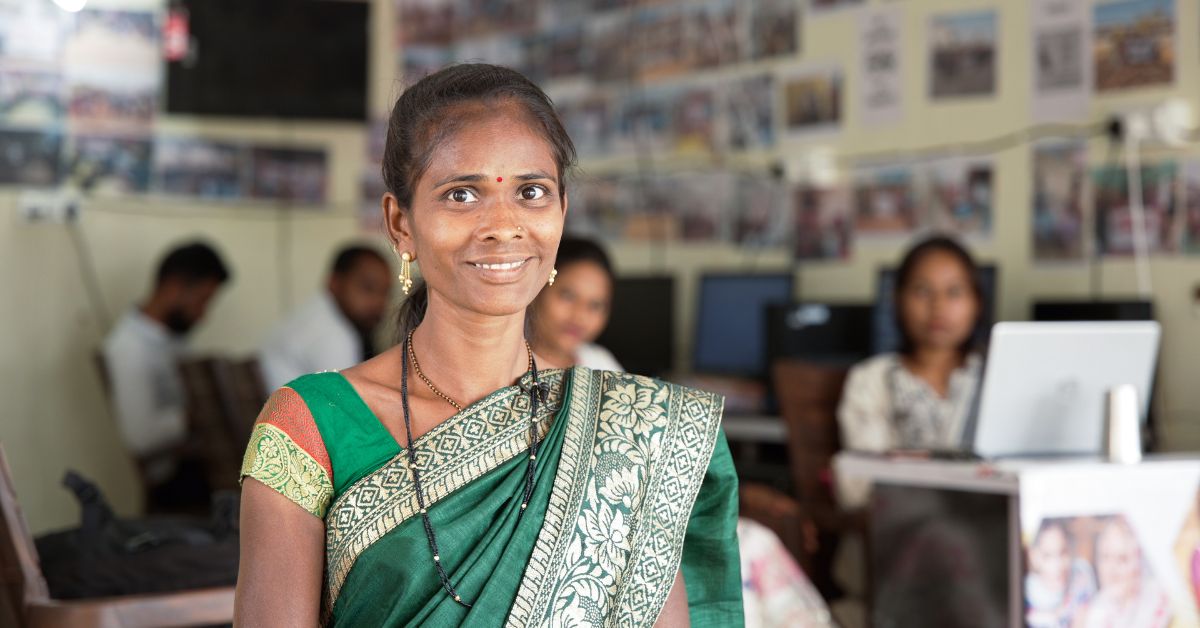Building Digital India: How One Idea Empowers 10 Lakh People With Lessons on Digital Future
Nasscom Foundation and DXC Technology have joined hands to bridge the digital gap in rural areas of India by establishing digital resource centres. Currently operational in 20 districts across the country, the programme has reached over 10 lakh people from marginalised communities.

This article has been sponsored by Nasscom Foundation
When Devanshi (18) from Rajasthan’s Sirohi lost her father at a young age, needless to say, it left a void behind. Her mother, now the sole breadwinner took to a business of sewing. However, the revenue was meagre. With no way forward in sight, uncertainty about the future was rife.
However, in the year 2021, hope was rekindled among the villagers in the form of digital resource centres. An endeavour by Nasscom Foundation — a non-profit organisation working with the tech industry — and IT pioneer DXC Technology, the initiative has since grown in scale. The partnership was conceived two years ago and was the coming together of two organisations for the greater good.
Devanshi was introduced to a whole new world where technology meets ingenuity. She spent hours at the resource centre grasping the nuances of Facebook and Instagram. In a couple of months not only she, but her entrepreneur mother too were pros. Together, the duo chiselled a new side to the business — one that would boast marketing through social media.
Sirohi is one of the rural towns that is seeing a new wave of digital literacy taking over. These learning centres equipped with computers and printers take on a bold avatar as hubs that encourage experiential learning.
The sheer expanse of e-books, magazines and newsletters in this repository provides gateways into the corporate world. While they channel the youth’s enthusiasm towards e-learning, they also act as support systems for the village women to integrate tech into their small-scale ventures.
An antidote to accessibility constraint
Voices across 20 districts in India with a focus on the aspirational districts — where these resource centres have been set up — unanimously echo the power of impact that they have had. These centres play host to skill-building initiatives that are slowly changing the fate of these villages.
As Lokendra Sethi, VP HR – India HR Lead at DXC Technology emphasizes, digital literacy is one of the initiatives they are creating impact with. The other initiative focuses on youth from rural areas who are empowered with technical skills and employability skills and further help them in providing job placement assistance.
For this, there are a plethora of courses — business process management, finance and accounting, Python and Java, machine learning and cyber security amongst others.
All these are directed towards the marginalised youth of the villages. As Nidhi Bhasin, CEO of Nasscom Foundation, points out, this is vital to tackle the talent gap in the tech industry. She adds, “It also does the work of bridging the gap between urban and rural India.”

Of over 10 Lakh beneficiaries who have been digitally enabled through this programme, half are women — a gender balance that points to a promising headstart the programme has achieved.
A potential to address biases
Nasscom Foundation has always shown an unparalleled reach. And according to Sethi, this is a testament to using CSR to create an impact in society. As he points out, the initiative’s core aim has always been to create a diversity of talent.
He explains, “We wanted to reach out to the pool of people who are diverse in terms of economics, gender or physical abilities. We wanted to encourage them to come into the mainstream of society.”
An interesting approach adopted was empowering the village women to take on the role of ambassadors. Today, over 1,000 community members known as ‘digital ambassadors’ go door to door encouraging the village people to visit the digital resource centres and equip themselves with skills. In contrast to a “corporate helicoptering into the village and dictating norms”, this idea is making the process more fun for the village people. They are being encouraged by their own.

As Sethi points out, this has helped them overcome fears about leveraging technology in the right ways. “A simple thing like how to keep an OTP secret or how to link an Aadhar card to the phone number was something novel for them but topics that were thoroughly enjoyed.”
Elaborating on these sessions centring around e-governance, Sethi says around 2.5 lakh people have benefitted from these schemes, adding that over 1,80,000 e-governance applications have successfully been processed.
What is amusing to him is that often the outcomes of these sessions are measured in terms of the audience’s excitement. Here, Bhasin interjects with an example she recalls of a single woman who has been single-handedly operating her paan shop in one of the villages.
“She would only take payments in cash and often these were small transactions. But when the literacy programme introduced her to UPI, it was a game changer.”
She adds, “Now, it’s easy for her to realise her earnings because she can see it immediately reflected in her account. The hassle of having to give back change to the customer is also eliminated as she gets the exact amounts paid to her. Operationally it’s easy for her.”

The roles and sizes of groups helmed by the digital ambassadors vary. Somedays they cater to sessions with over 2,000 people while other days the groups are smaller ranging in size from a handful to 30.
The programme’s overarching aim to blow wind into the sails of the youth in rural India by empowering them with digital skills is a stepping stone to a much bigger milestone. As Bhasin puts it, “If you empower even one person, you are empowering an entire family.”
Edited by Pranita Bhat
If you found our stories insightful, informative, or even just enjoyable, we invite you to consider making a voluntary payment to support the work we do at The Better India. Your contribution helps us continue producing quality content that educates, inspires, and drives positive change. Choose one of the payment options below for your contribution- By paying for the stories you value, you directly contribute to sustaining our efforts focused on making a difference in the world. Together, let’s ensure that impactful stories continue to be told and shared, enriching lives and communities alike. Thank you for your support. Here are some frequently asked questions you might find helpful to know why you are contributing?

This story made me
-
97
-
121
-
89
-
167













